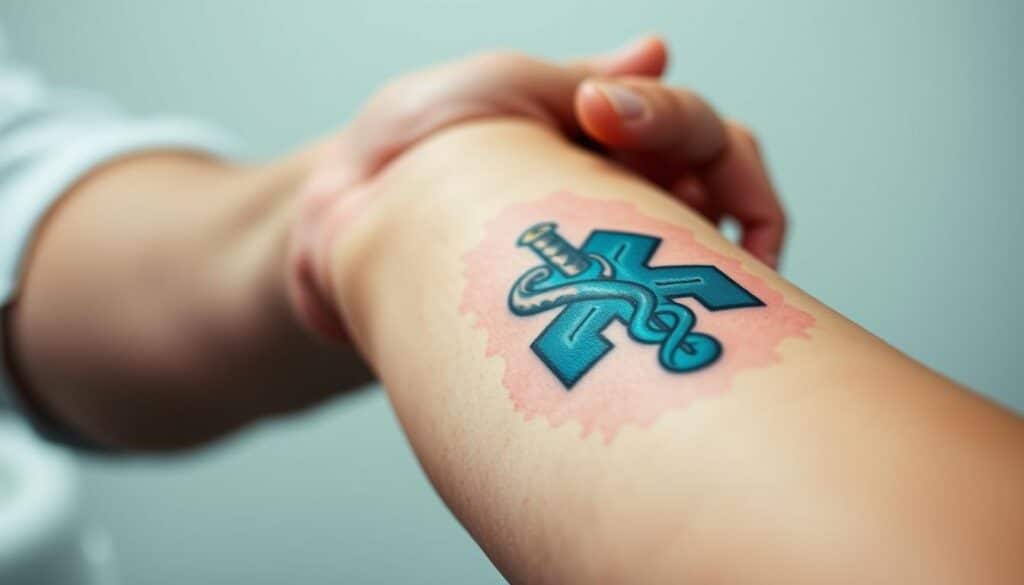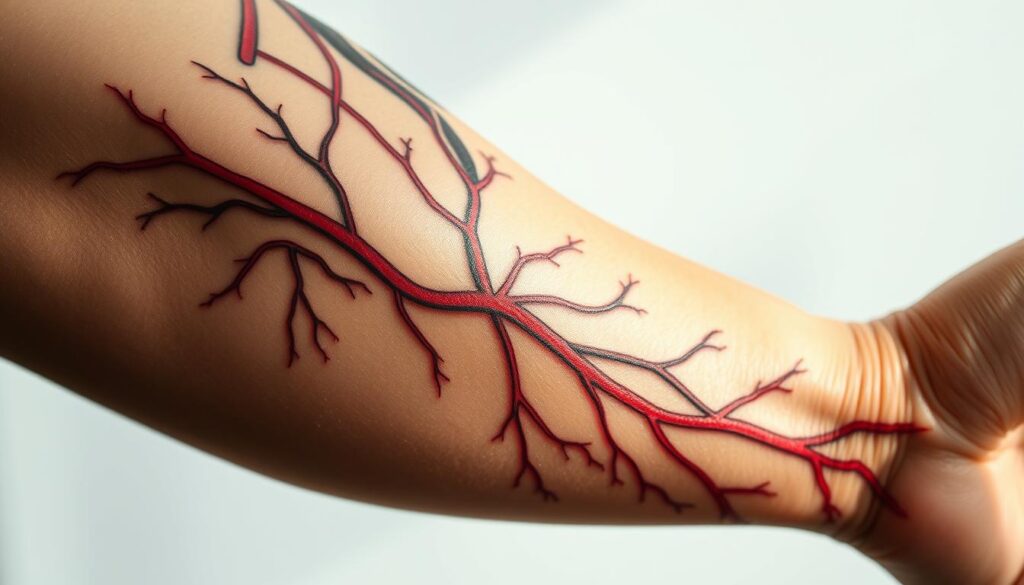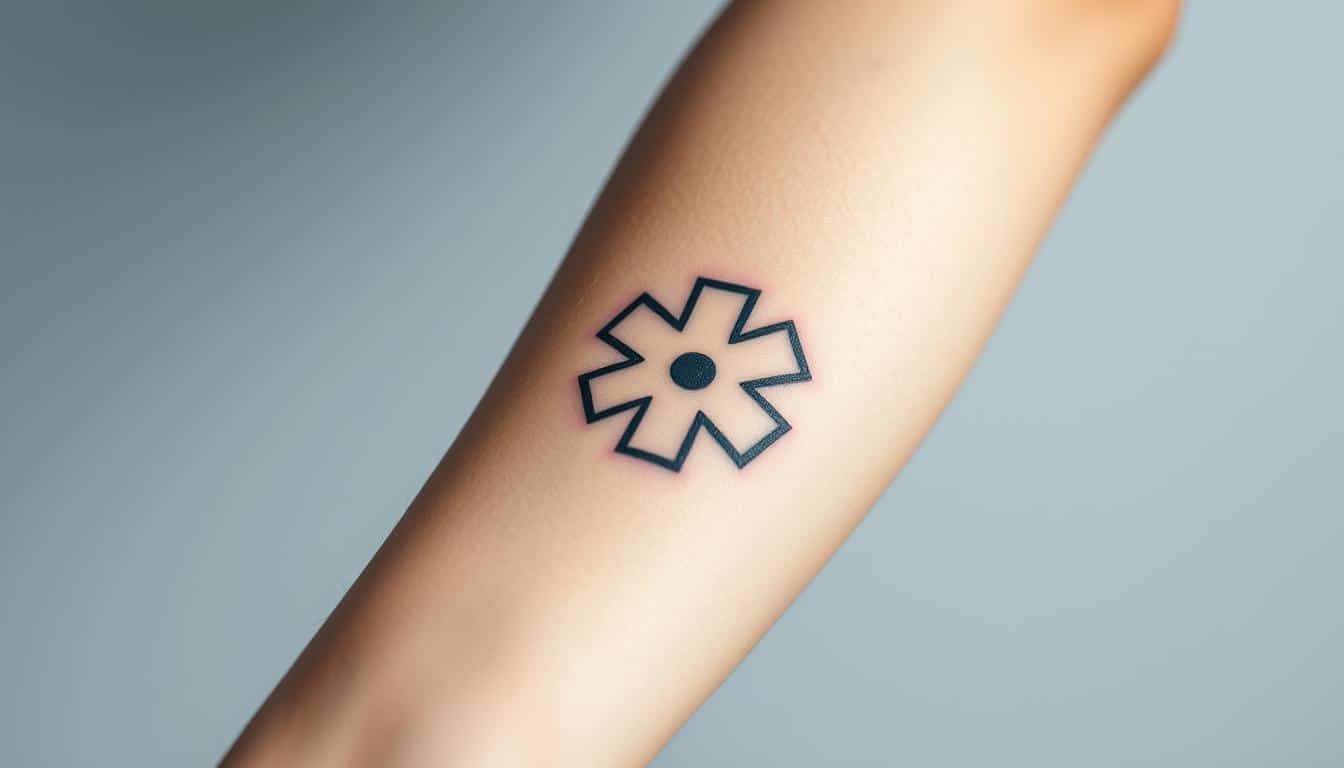Body art offers a powerful way to express yourself, but managing diabetes requires careful planning. The good news? With proper precautions, tattoos can be a safe option. Many individuals with this condition already handle daily injections and blood tests, making the needle process familiar.
Success starts with controlled blood sugar levels. High glucose can slow healing and raise infection risks. Always consult your doctor before booking an appointment. Reputable studios follow strict hygiene protocols, but your body’s response depends on personal health factors.
Your daily routine already involves managing needles and monitoring blood—skills that translate well to tattoo aftercare. Discuss your condition openly with the artist. Some even choose medical alert designs to communicate their needs discreetly.
This guide walks you through every step: selecting a studio, preparing your skin, and ensuring long-term ink vibrancy. By combining medical advice with creative vision, you can confidently embrace body art while prioritizing wellness.
Understanding Tattoos and Diabetes
Creating permanent body art involves more than artistic skill—it’s a medical interaction with your skin’s biology. Modern tattoo machines puncture the dermis up to 300 times per minute, depositing ink through micro-injuries. This process temporarily weakens your body’s largest protective organ.
How Needles Interact With Skin Layers
Repeated needle penetration disrupts the skin barrier, creating pathways for potential contaminants. While healthy bodies repair these openings efficiently, type 1 or type 2 diabetes alters this equation. Elevated glucose levels thicken blood vessels, reducing oxygen flow to healing areas.
Healing Challenges and Defense Mechanisms
Uncontrolled blood sugar levels slow cell regeneration and compromise white blood cell function. This dual effect increases infection risk and extends recovery timelines. Even well-managed diabetes requires extra precautions—your skin might react unpredictably to pigments or aftercare products.
Reputable studios follow FDA sterilization standards, but communication remains vital. Inform your tattoo artist about your condition so they can adjust techniques. Monitoring glucose before and after sessions helps your body allocate resources effectively for wound repair.
Medical consultations ensure your treatment plan aligns with the physical demands of ink aftercare. Understanding these biological factors empowers safer decisions about placement, size, and aftercare routines.
Preparing for Your Tattoo Experience
Smart preparation transforms body art from a risk to a rewarding journey. Three pillars form your safety foundation: medical guidance, metabolic stability, and studio vetting.
Consulting With Your Doctor
Begin with a healthcare provider review. Endocrinologists recommend HbA1c levels below 7% for safe healing. Discuss medication adjustments and infection prevention strategies tailored to your needs.
Monitoring Blood Sugar and A1C Levels
Track glucose readings for two weeks pre-appointment. Stable blood sugar control helps skin repair efficiently. Studies show optimal healing occurs when fasting levels stay under 130 mg/dL.
Choosing a Licensed and Hygienic Tattoo Studio
Verify state certifications and autoclave sterilization practices. The American Diabetes Association suggests asking artists about diabetic clients’ experiences. Pack glucose tablets and schedule morning sessions when insulin levels are most predictable.
Reputable studios welcome questions about needle disposal and pigment ingredients. Plan 15-minute breaks for every two hours under the needle. This proactive approach reduces stress on your body and ensures artistic precision.
Can Diabetics Get Tattoos: Essential Safety Measures
Prioritizing safety transforms tattoo sessions from stressful to successful. Clear communication and strategic planning reduce risks while preserving your health. Start by selecting artists experienced with chronic conditions.

Transparency With Your Tattoo Professional
Disclose your diabetes diagnosis before booking. Skilled artists adjust techniques for slower healing rates and infection prevention. Ask about their experience working with clients managing blood sugar fluctuations.
Discuss break schedules to maintain glucose control. Reputable studios accommodate snack times and quick blood checks. This openness helps artists plan shorter sessions that minimize physical stress.
Optimizing Session Structure
Break longer designs into multiple appointments. Three-hour maximum sessions prevent blood sugar spikes from prolonged stress. Move positions frequently to maintain circulation during intricate work.
Pack fast-acting carbohydrates and continuous glucose monitors. The American Diabetes Association recommends testing levels every 90 minutes. Hydrate well and avoid caffeine to stabilize vital signs.
These measures create safer conditions for body art. Partnering with informed professionals reduces infection risks while achieving your vision. Always prioritize health monitoring over rushed completion.
Managing Risks and Tattoo Placement Considerations
Strategic placement becomes your first defense against complications. Areas with strong blood circulation heal faster and resist infections more effectively. This principle guides safer decisions for lasting results.

Identifying High-Risk Areas for Reduced Circulation
Feet and lower legs face unique challenges. The shins and ankles have thinner skin layers and slower nutrient delivery. Buttocks also pose risks due to pressure points affecting circulation during prolonged sitting.
High blood sugar compounds these issues by thickening vessel walls. This reduces oxygen flow to extremities. Choosing upper arms or shoulders often supports better recovery.
Preventing Infection and Recognizing Warning Signs
Watch for warmth or pus around new ink. These signal potential skin infections requiring immediate care. Red streaks spreading from the site demand urgent medical attention.
Clean the area gently with fragrance-free soap. Avoid soaking tattoos in baths or pools for three weeks. Moisturize with products your artist approves – some lotions trap bacteria.
Your body’s healing timeline might extend beyond standard estimates. Patience prevents scarring and preserves ink clarity. If a location feels problematic during aftercare, consult your healthcare team about alternative placements.
Aftercare Guidance and Long-Term Healing Tips
Proper aftercare becomes your tattoo’s best ally for vibrant, lasting results. Unlike standard healing processes, managing blood sugar adds complexity to skin recovery. Consistency in care routines helps prevent complications while preserving ink quality.
Proper Cleaning, Moisturizing, and Healing Practices
Wash the area gently twice daily using lukewarm water and pH-balanced soap. Pat dry with a clean paper towel—avoid rubbing. Apply a fragrance-free moisturizer immediately after drying to lock in hydration.
Resist picking at scabs, even if itching occurs. Scrubbing disrupts delicate healing tissues. Use cool compresses to soothe irritation instead of scratching.
Understanding Extended Recovery Time
Healing often takes 3-4 weeks instead of the typical 14 days. Monitor for unusual redness or swelling beyond the first week. Contact your doctor if warmth persists or pus develops.
Insulin management and stable glucose levels accelerate cell repair. Test more frequently during recovery phases. Carry fast-acting carbs during follow-up appointments.
Your body’s timeline depends on placement and overall health. Annual checkups help maintain skin integrity for years. View aftercare as part of your wellness strategy—not just tattoo preservation.
Conclusion
Living with diabetes doesn’t mean sacrificing meaningful self-expression. Through careful preparation and expert collaboration, body art becomes an achievable goal that celebrates your resilience. Partnering with your healthcare team and choosing licensed professionals ensures every step prioritizes safety.
Stable blood sugar levels and consistent monitoring form the foundation for successful healing. The American Diabetes Association emphasizes open communication with artists about your needs – many studios now accommodate medical considerations during sessions. Proper aftercare routines protect both your skin and the artwork’s longevity.
Strategic placement choices and session planning reduce risks while preserving creative freedom. Consider designs that honor your journey, like discreet medical alert symbols or imagery with personal significance. Resources from diabetes organizations provide updated guidance for maintaining wellness with ink.
Your body tells a powerful story. With thoughtful planning and trusted partnerships, you can confidently transform your art into a lasting testament to strength. Every informed decision – from consultation to aftercare – empowers you to embrace this form of self-expression safely.
FAQ
How does diabetes impact tattoo healing?
High blood sugar levels can slow wound recovery and increase infection risks. Proper glucose control before and after the procedure is critical to support your body’s natural healing process.
What blood sugar range is safe for getting inked?
Aim for stable glucose levels within your target range for at least 48 hours prior. Consult your healthcare provider to confirm your A1C is well-managed, typically below 7%, to minimize complications.
Are certain body areas riskier for tattoos with diabetes?
Avoid the shins, ankles, and feet due to poor circulation. These zones heal slower and face higher infection risks. Opt for areas with better blood flow, like the upper arms or thighs.
Should you inform the tattoo artist about your condition?
Always disclose your diagnosis. Reputable artists will adjust techniques, prioritize hygiene, and may avoid high-risk placements. Bring medical documentation if required by the studio.
What aftercare steps reduce infection chances?
Clean the site 2-3 times daily with fragrance-free soap, apply antibiotic ointment, and avoid soaking. Monitor for redness, swelling, or discharge—key signs of potential skin infections.
Can medical alert tattoos replace traditional IDs?
While some choose symbols like a caduceus or “Type 1” text, these aren’t universally recognized. Pair them with a physical ID bracelet for emergency situations.
How long does healing take for someone with diabetes?
Expect a 2-4 week recovery period, potentially longer if circulation is compromised. Follow your artist’s aftercare plan and schedule follow-ups with your doctor if healing stalls.


